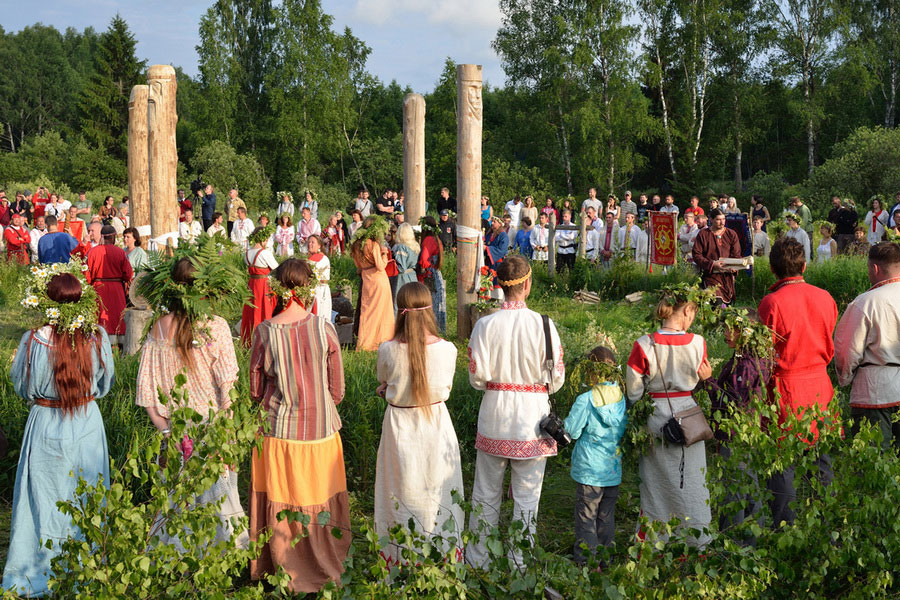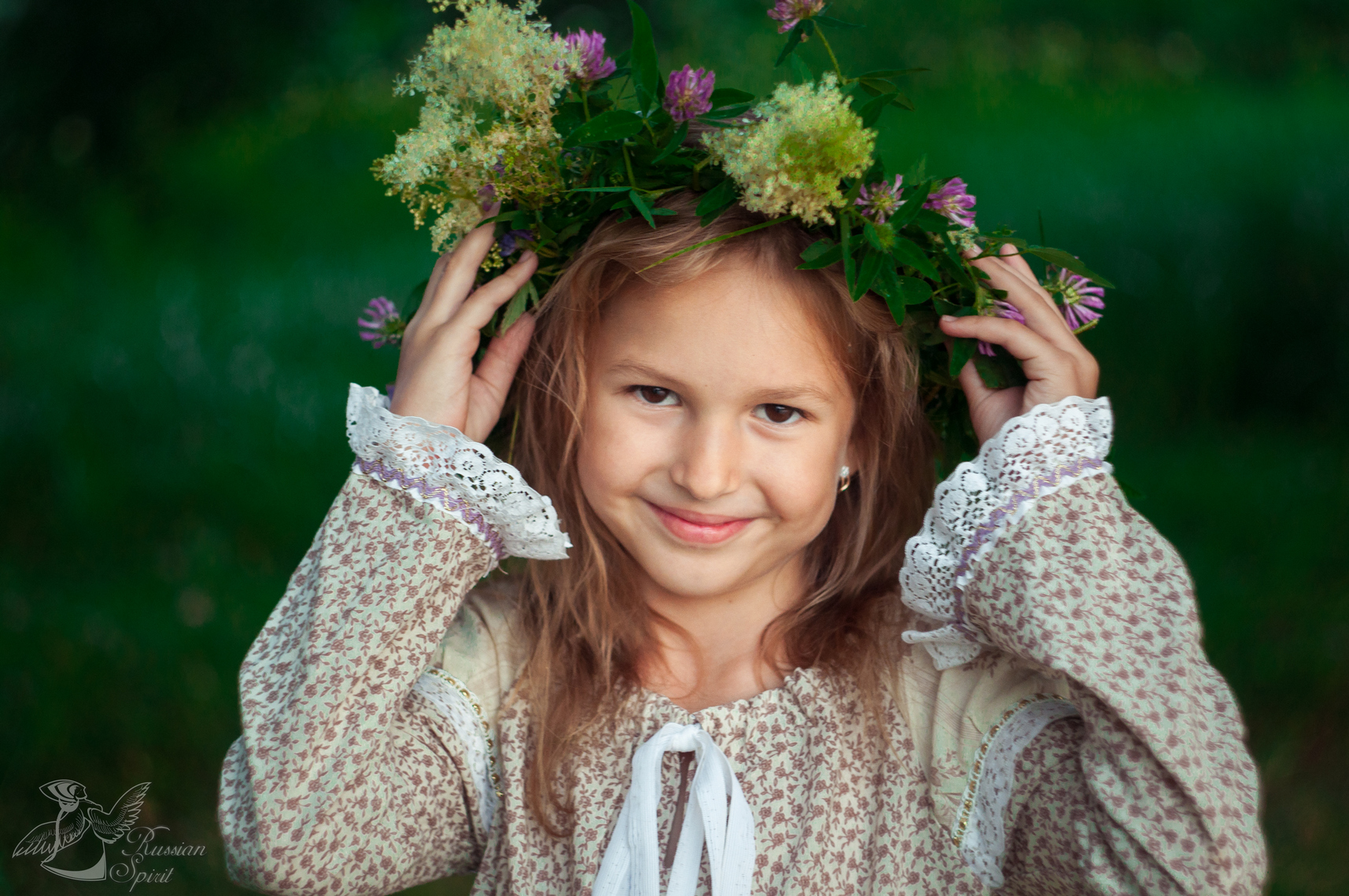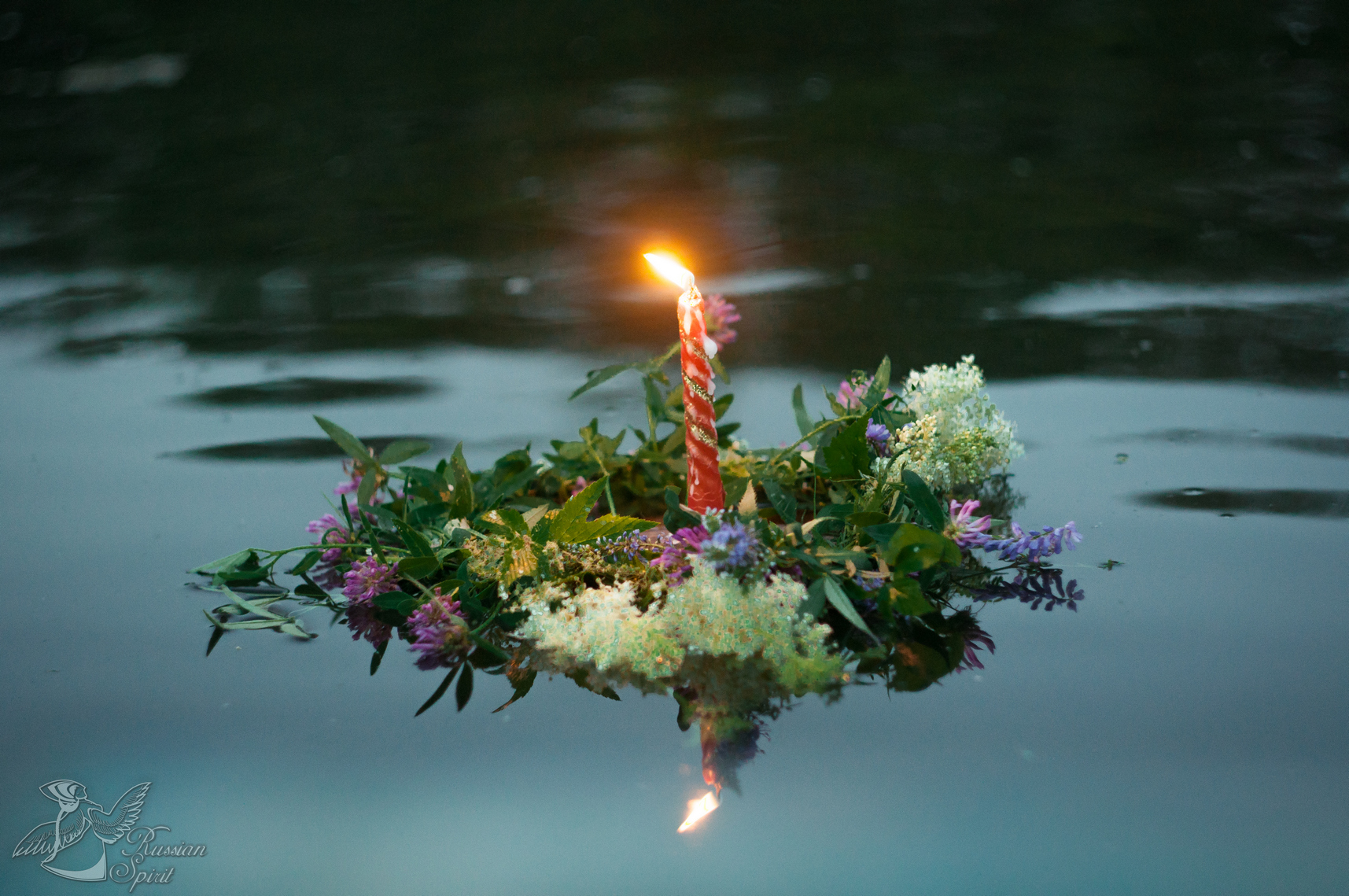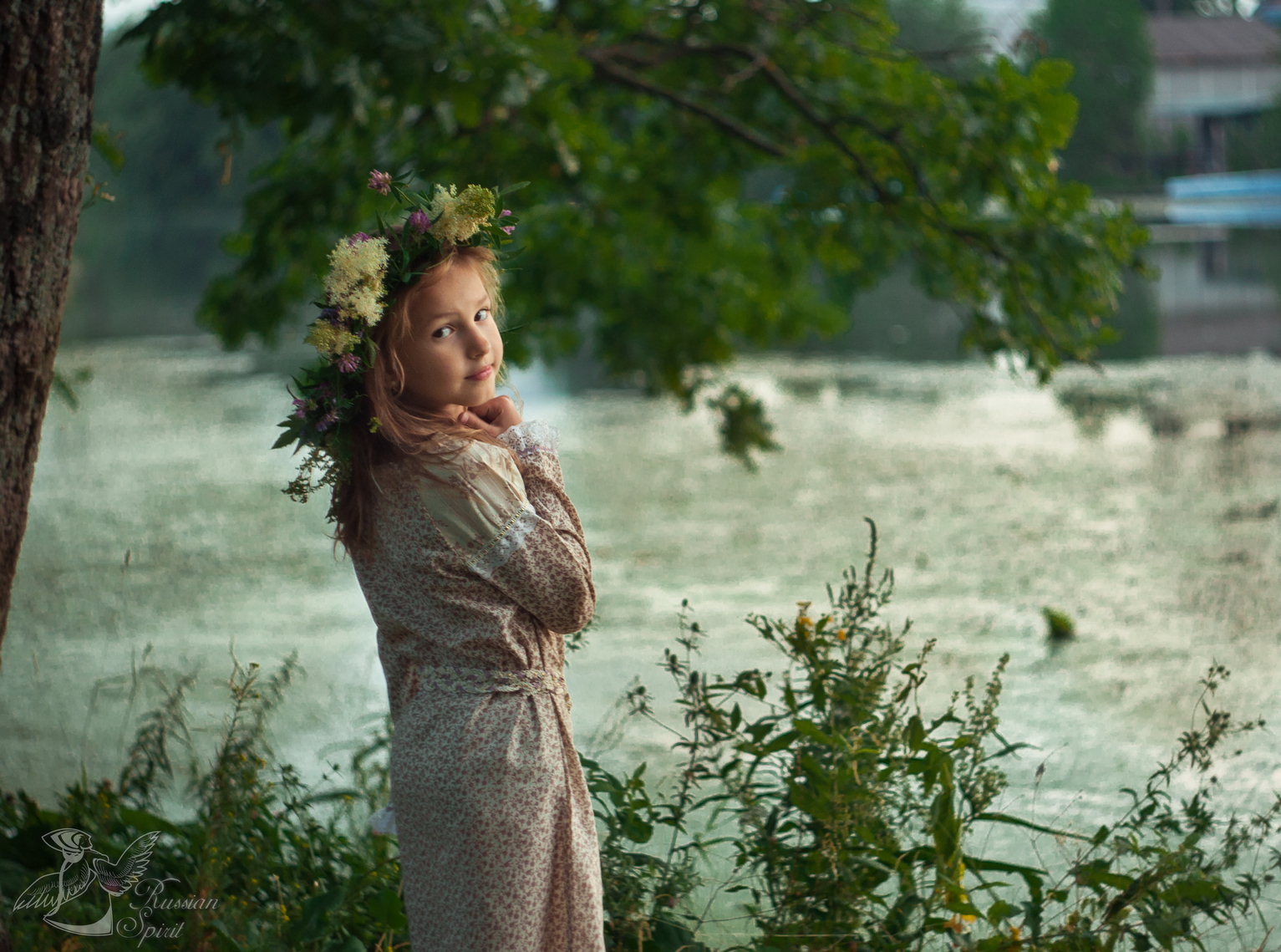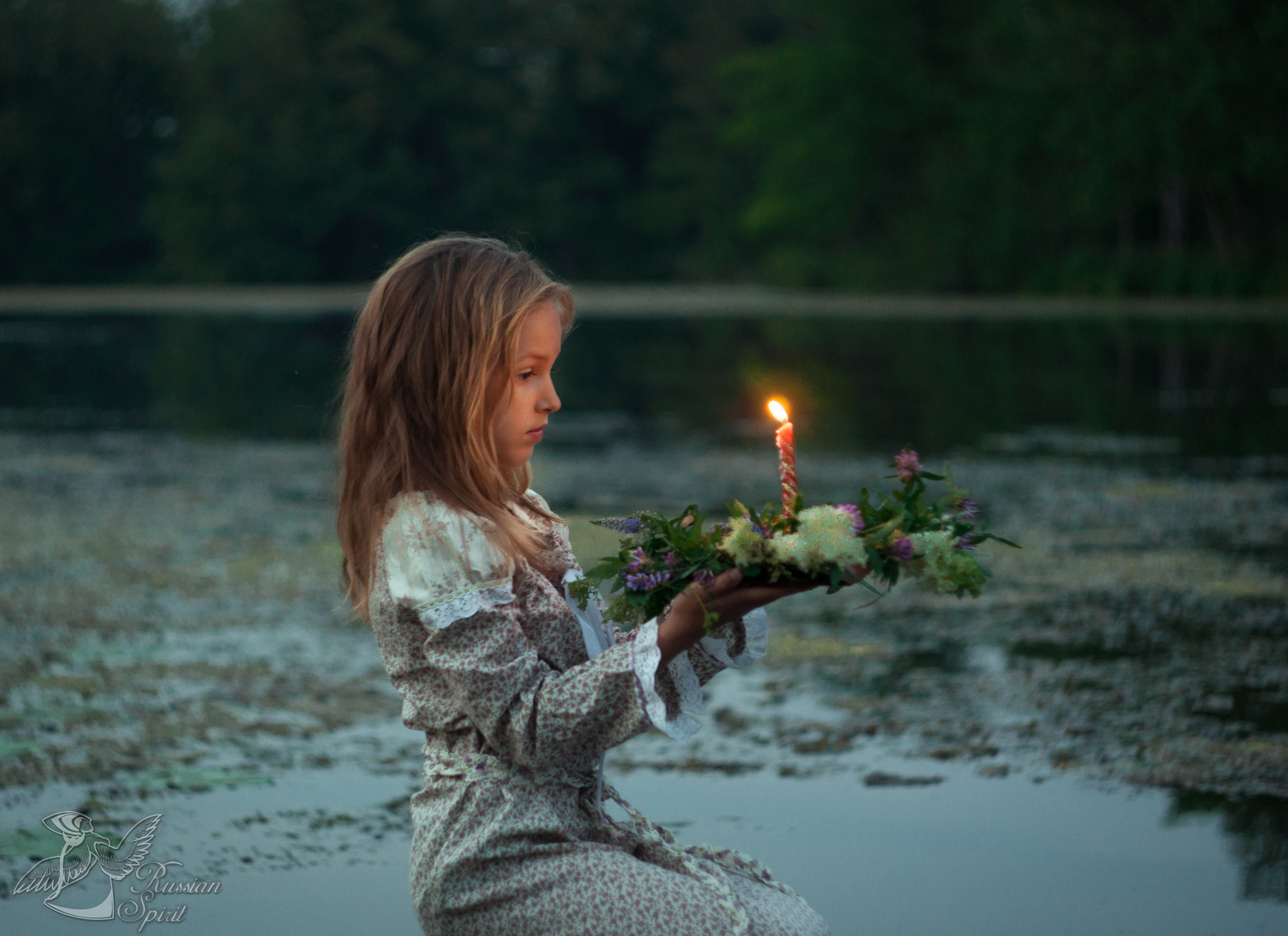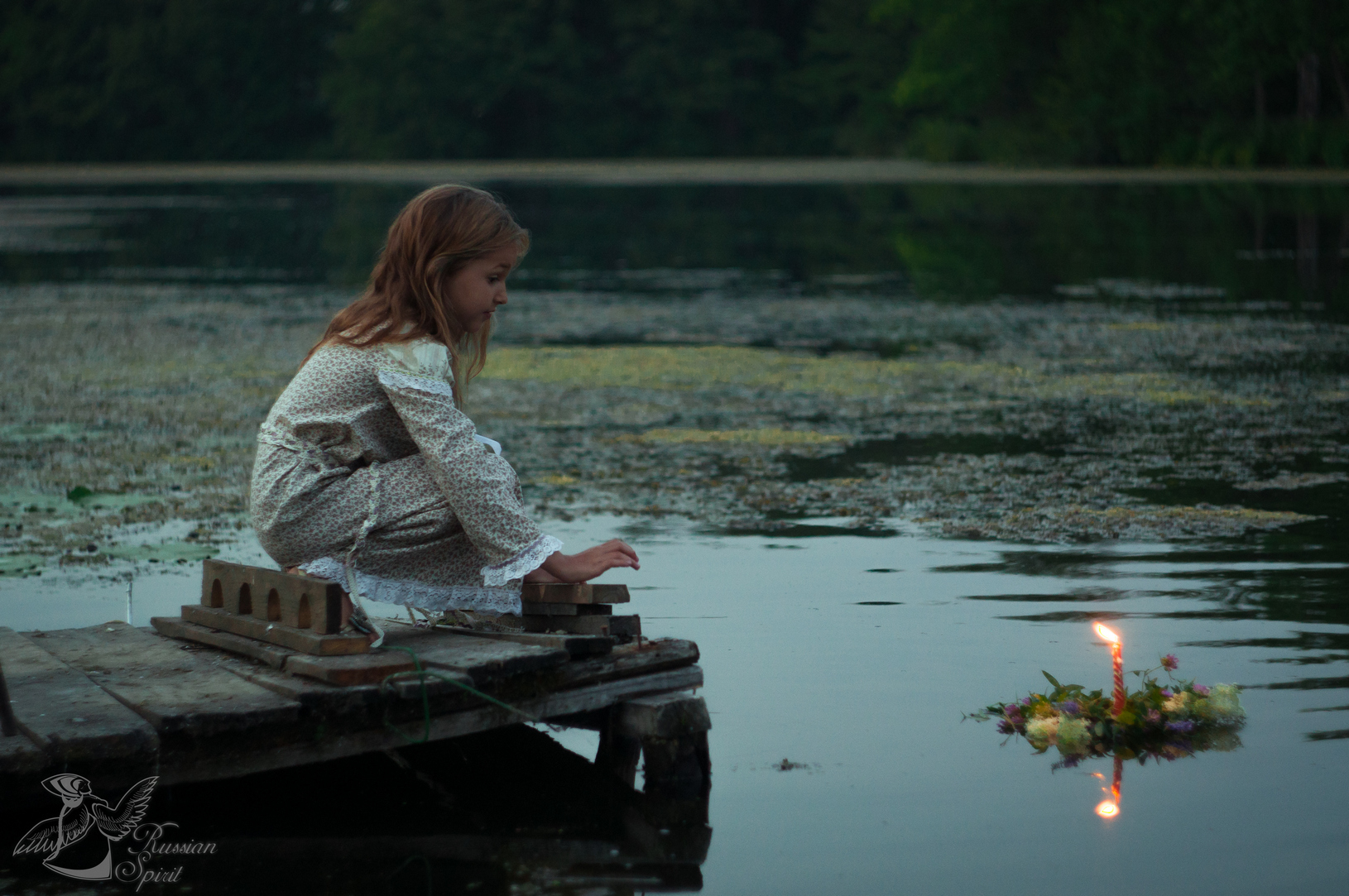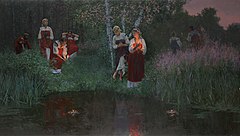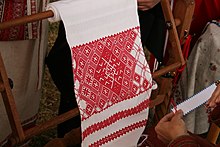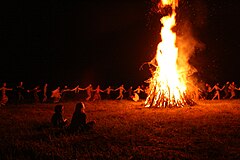- Home
- Russia
- Traditions
- Ivan Kupala
Since ancient times all peoples of the world have celebrated the end of June, the peak of the summer. Russia’s version of such a holiday is Ivan Kupala. On the night of 23 June, everyone celebrated this mystical but at the same time jolly holiday full of ritual acts, rules and prohibitions, songs, chants and all kinds of fortune-telling, legends, and beliefs.
Even in the time of the ancient pagan deity Ancient Russians used to have Kupalo, the God of summer fertility. In his honor people of sang songs and jumped over the bonfire. This ritual act has become an annual celebration of summer solstice, combining a pagan and Christian traditions. Kupala got the name Ivan after the baptizing of Russia, when he was replaced by John the Baptist (the way he was percepted by common people), who baptized Christ and whose birthday was celebrated on 24 June.
Ivan Kupala Rituals in Russia
On that day people wore girths of flowers and wreaths of herbs. They reeled, sang songs, stoked bonfires with poles topped by burning wheel, the symbol of the sun.
Songs that were sung in villages mentioned Kupala as loving, clean, and cheerful. On the day of Ivan Kupala girls made wreaths of herbs, and in the evening let them float on the water watching them go away. The sinking wreath meant the end of love and that there would be no wedding.
Another tradition was to pour dirty water on everyone in sight. It was believed that the more often people run to swim the purer their souls would become. The most healing swimming was considered at dawn.
The swimming night was lit with purifying bonfires to dance around and jump over. The highest jumper was the luckiest. Mothers used to burn the shirts of their sick children in those bonfires hoping to get rid of the awful In diseases. Young people participated in noisy games, brawls, running competitions. The most played was the game of race-and-catch.
People believed that all the miraculous and healing herbs bloomed during Ivan Kupala night. Therefore, knowledgeable and experienced people, and especially the village healers never missed that night and collected medicinal roots and herbs to keep for the whole year ahead.
There was a rumor that at midnight fern starts to bloom. Miraculous fiery flower could point to a buried treasure no matter how deep it had been hidden. Around midnight a bud appeared on the wide leaves. It rose higher and higher and then started to ”jump” around. As midnight came, the ripe bud burst and a fiery red flower came out. No man could pick up the flower. But if you saw it any wish would come true.
There was always something miraculous about the day of Ivan Kupala. No one slept at night, since it was believed that all evil became active: witches, werewolves, vampires, mermaids … People thought that Ivan Kupala was the day when witches had their holiday too, trying to cause as much harm to humans as they possibly could.
That was how the holiday of Ivan Kupala used to be — rituals, divination and other cheerful and lovely pranks…
Today Russian church celebrates one more interesting holiday that originates in paganisme – Ivan Kupala holiday.
In the old time the Slavs attributed this holiday to summer solstice 20-21 of June by old calendar. As soon as the christianity was accepted, the people didn’t reject and forget this holiday and the church attributed it to the Day of John the Baptist, which falls on the 24 of June by old calendar or 7th of July by new calendar.
The holiday of Kupala (i.e. bathing holiday) was very respected by east Slavs and its pagan character is conserved through many centuries.
It was time of the highest flowering of nature: the sun in zenith, the plants in full flowering, the fruit start ripening. Thus the magical force of fire, water, earth and plants was so big, that they had medicinal and protective properties. The participation in the rituals ensured good fortune for the whole year.
At night people used to make many rituals, games and fortune-tellings. So the most important forces in the night of Ivan Kupala were water, fire and plants. People gathered medicinal herbs and made wreaths, burnt big fires, jumped over them in order to drive the sickness away, burnt out the old clothes in order to be cleansed, bathed in rivers and lakes or went to banya if there was no river by side.
In the morning the Slavs used to wash with dew that also had its magical properties to heal.
One of the most popular rituals was the fortune-telling by means of a wreath made from medicinal herbs. They put a candle into a wreath and launched in water. Everyone attentively looked at his wreath:
- If it goes too fast, it means happy life
- If the candle doesn’t die out, it means very long life
- If the wreath sank, the young woman won’t get married this year
The main flower that nignt was a fern flower. By legend if to find this bright and rare flower which appears only at Kupala night and blossoms only during some hours, it will bring much happiness and indicate the way to find a treasure.
This great holiday full of magic, mystics and revealing strong and wise character of our ancestors, is not forgotten nowadays and is celebrated in many Slav countries. In Russia we organize games, festivals and bathing in rivers and lakes especially for children. Of course it is not apprehended so seriously as before but more just to have fun and conserve the traditions.
- Главная
- Топики
- Праздники и традиции
Kupalle celebrate on June 21. It is a traditional and the most loved holiday in Belarus.
Kupalle is a pagan summer celebration of fertility in the name of a female God — Kupala. Lately it was renamed into a Christian celebration of male saint-Ivan Kupala.
Kupalle usually involves youth going into a forests and the meadows, wearing flowers and grass garlands, dancing in karagods (circles around fires), jumping through fires.
A popular kind of Kupalle was fortune-telling – putting wreaths on water. People believed that on Kupalle night the fern has a very special flower-«paparats-kvetka»- glowing in the dark. If you find the flower, you’ll be happy. But no one has found «paparats-kvetka» yet.
Версия для печати
Другие топики по теме:
- Holidays in Great Britain
- Halloween
- Father’s Day
- Customs and traditions of english speaking countries
- Thanksgiving Day (2)
- Fireplaces
- Cultures and national stereotypes
- Public holidays
- July 4 th — Independence Day
- USA Holidays
- Весь список
From Wikipedia, the free encyclopedia
| Kupala Night | |
|---|---|

Night on the Eve of Ivan Kupala, |
|
| Also called | Feast of St. John the Baptist; Иван-Купала; Купалле; Іван Купала; Noc Kupały |
| Observed by | Slavic people |
| Significance | celebration relates to the summer solstice |
| Date |
|
| Related to | Summer Solstice, Nativity of St. John the Baptist |
Kupala Night (Belarusian: Купалле, Polish: Noc Kupały, Russian: Иван-Купала, Ukrainian: Івана Купала, Купайла), also called Ivanа Kupala, is a traditional Slavic holiday that was originally celebrated on the shortest night of the year, which is on 21-22[citation needed] or 23-24 of June (Czech Republic, Poland and Slovakia) and in Eastern Slavic countries according to traditional Julian calendar on the night between 6 to 7 July (Belarus, Russia and Ukraine). Calendar-wise, it is opposite to the winter holiday Koliada. The celebration relates to the summer solstice when nights are the shortest and includes a number of Slavic rituals.[1][2] It involves herb collecting, bonfire lighting, and bathing in the river.[3]
History[edit]
Simon Kozhin. Kupala Night, Divination on the Wreaths (2009).
The name of the holiday was originally Kupala; a pagan fertility rite later adapted into the Orthodox Christian calendar by connecting it with St. John’s Day which is celebrated on 24 June.[4] Eastern Christianity uses traditional Julian calendar which is misaligned with actual solstice; 24 June in Julian calendar falls on 7 July in more modern Gregorian calendar.[2]
This holiday symbolizes the birth of the summer sun – Kupalo. In the 4th century AD, this day was proclaimed the holiday of the birth of John the Baptist – the forerunner of Jesus Christ. As a result of the Christianization of the pagan feast the name «Kupala» got connected with the Christian «Ivan».[5]
The Ukrainian, Belarusian name of this holiday combines «Ivan» (Joan/Johan/John, in this case John the Baptist) and Kupala which was thought to be derived from the Slavic word for bathing, which is cognate. However, it likely stems from the proto-Slavic kump, a gathering. The two feasts could be connected by reinterpreting John’s baptizing people through full immersion in water. However, the tradition of Kupala predates Christianity. The pagan celebration was adapted and reestablished as one of the native Christian traditions intertwined with local folklore.[6]
Folklore and Slavic religious beliefs[edit]
Івана Купала (Ivanа-Kupala). Stamp of Ukraine (1998)
Many of the rites related to this holiday are connected with the role of water in fertility and ritual purification. This is due to the ancient Kupala rites.
On Kupala day, young people jump over the flames of bonfires in a ritual test of bravery and faith. The failure of a couple in love to complete the jump, while holding hands, is a sign of their destined separation.
Wreath thrown in water on Ivan Kupala Day Feast of St. John the Baptist
Girls may float wreaths of flowers (often lit with candles) on rivers, and attempt to gain foresight into their romantic relationship fortune from the flow patterns of the flowers on the river. Men may attempt to capture the wreaths, in the hope of capturing the interest of the woman who floated it.
Ceremonial making a fire. Kupala Night near Ślęża, Poland. June 18, 2022
There is an ancient Kupala belief that the eve of Ivan Kupala is the only time of the year when ferns bloom. Prosperity, luck, discernment, and power befall whoever finds a fern flower. Therefore, on that night, village folk roam through the forests in search of magical herbs, and especially, the elusive fern flower.
Traditionally, unmarried women, signified by the garlands in their hair, are the first to enter the forest. They are followed by young men. Therefore, the quest to find herbs and the fern flower may lead to the blooming of relationships between pairs within the forest.
Ferns are not angiosperms (flowering plants), and instead reproduce by spores; they cannot flower.
In Gogol’s story The Eve of Ivan Kupala (also called Saint John’s Eve), a young man finds the fantastical fern-flower, but is cursed by it. Gogol’s tale was adapted by Yuri Ilyenko into a film of the same name, and may have been the stimulus for Modest Mussorgsky to compose his tone poem Night on Bald Mountain.
See also[edit]
- Midsummer
- Wianki (Poland)
- Kupala
- Kupalinka (Kupala Night Maiden), popular Belarusian song
- Kupolė
- Jāņi
- Semik — a related spring holiday.
- Janka Kupała — the pen-name of this Belarusian author refers to his birthday of July 7.
- Loi Krathong — Thai autumn festival when people leave wreaths with candles on rivers
- Chaharshanbe Suri — Iranian festival celebrated on the eve of the last Wednesday of the year
References[edit]
- ^ website «Guide to Russia» [1] Archived 2017-01-09 at the Wayback Machine
- ^ a b Megre, Vladimir (2008). Rites of Love. Ringing Cedars Press LLC. p. 231. ISBN 9780980181289. Retrieved 2020-07-15.
- ^ Tryfanenkava, Maryna A. 2001. “The Current Status of Belarusian Calendar-Ritual Tradition”. In: FOLKLORICA — Journal of the Slavic, East European, and Eurasian Folklore Association 6 (2): 44-45. https://doi.org/10.7161/folklorica.v6i2.3709.
- ^ Niżegorodcew (et alii), Anna (2011). Developing Intercultural Competence through English: Focus on Ukrainian and Polish Cultures. Warsaw: Developing Intercultural Competence through English: Focus on Ukrainian and Polish Cultures Anna Niżegorodcew , Yakiv Bystrov , Marcin Kleban Wydawnictwo UJ. p. 91. ISBN 9788323384366.
- ^ «Ivan Kupala Day». authenticukraine.com.ua. Retrieved 2022-05-19.
- ^ «/culture_art/traditions». russia-ic.com/. Retrieved 31 October 2014.
External links[edit]
- Купалле
- Ukrainian Kupala (alt. Kupalo, Kupailo) traditions
- The Day of Ivan Kupala as it has survived in the Vologda Region
- Kupalle holiday in Belarus (video) Archived 2020-09-27 at the Wayback Machine on the Official Website of the Republic of Belarus Archived 2020-04-02 at the Wayback Machine
- Kupala Night in Poland
Ivan Kupala (Midsummer Day, Kupala Night) is one of the main holidays of the Slavic calendar, coinciding with the Nativity of John the Baptist.
Kupala ceremonies performed on the eve of the holiday (“the night on the eve of Ivan Kupala”) make up a complex ritual complex, including: gathering herbs and flowers, making wreaths, decorating buildings with greenery, making bonfires, destroying stuffed animals, jumping over a fire or through bouquets of greenery, dousing water, fortune telling, witch tracking, nightly atrocities.
Ivan Kupala or Kupayla — since ancient times, is known among the Slavs as a holiday of the Sun, the maturity of summer and green mowing. People girded around with flower bands, wreaths of herbs were put on their heads. Drove round, sang songs. The old people, using the friction of dry sticks, produced «live fire», made bonfires, in the middle of which they put a pole with a burning wheel mounted on it — a symbol of the sun. Kupala holidays were celebrated during pagan times in honor of the God of the Sun, whose wife was the luminiferous Charge, the red maiden.
After the transition to a new style, the holiday of Ivan Kupala falls on July 7, more precisely, on the night of July 7. Some European countries celebrate St. John’s Day or St. Ivan’s Day (the likeness of Ivan Kupala) in the old style, during the summer solstice.
Иван Купала (Иванов день, Купальская ночь) — один из главных праздников календаря славянских народов, совпадающий с Рождеством Иоанна Крестителя.
Купальские обряды, совершаемые в канун праздника («ночь накануне Ивана Купалы»), составляют сложный обрядовый комплекс, включающий: сбор трав и цветов, плетение венков, украшение зеленью построек, разжигание костров, уничтожение чучела, перепрыгивание через костер или через букеты зелени, обливание водой, гадания, выслеживание ведьмы, ночные бесчинства.
Иван Купала или Купайла — с древнейших времен известен у славян как праздник Солнца, зрелости лета и зеленого покоса. Люди опоясывались перевязями из цветов, на голову надевали венки из трав. Водили хороводы, пели песни. Старики с помощью трения сухих палочек добывали «живой огонь», разводили костры, в середину которых ставили шест с укрепленным на нем горящим колесом — символом солнца. Купальские праздники совершались во времена язычества в честь Бога Солнца, супругой которого была светоносная Заряда, красная девица.
Ivan Kupala (Ivanovs Night, Ivanovs Day) is one of the main holidays of the calendar of the Slavs, coinciding with the Nativity of John the Baptist. After the transition to a new style of the holiday falls on July 7, more precisely, the night of July 7. Some European countries celebrate Ivanovs Day or St. Ivans Day (the likeness of Ivan Kupala) in the old style, during the summer solstice — June 20-26.
Kupala holiday since ancient times was one of the most vivid and revered among the Eastern Slavs. His pagan character persisted for centuries. The significance of the holiday was due to the fact that it was celebrated at the turn of two periods of the solar year cycle, which was the basis of the ancient agricultural calendar. This was the time of the highest solar activity, followed by a change in the movement of the sun across the sky, which, as people thought, turned or «shifted» for the winter. As a result of such a «shift» the shone in the following months of the calendar year gradually «faded away»: the day became shorter and the night was longer.
In the Christian worldview, the image of the «departing» sun began to be perceived as a symbol of John the Baptist, whose date of birth coincided with the day of the summer solstice. In the Eastern and Western traditions, the saint was endowed with such epithets as light, a torch preceding the Sun, correlated with the image of Jesus Christ.
Within the framework of the national calendar Ivan Kupala formed a single festive cycle together with Agrafena Kupalnitsas days (July 6) and the holy apostles Peter and Paul (Petrov day, July 12).
Kupala holidays were celebrated in the time of paganism in honor of the Sun God, whose wife was a luminous Charge, Dawn-lightning, a red girl.
А вот и перевод
Иван Купала (Иванова ночь, Иванов день) — один из главных праздников календаря славян, совпадающий с Рождеством Иоанна Крестителя. После перехода на новый стиль праздник приходится на 7 июля, точнее, в ночь на 7 июля. Некоторые европейские страны отмечают Иванов день или День святого Ивана (подобие Ивана Купалы) по старому стилю, в дни летнего солнцестояния — с 20 по 26 июня.
Купальский праздник издревле был одним из самых ярких и почитаемых у восточных славян. Его языческий характер сохранялся на протяжении веков. Значимость праздника обуславливалась тем, что отмечался он на рубеже двух периодов солнечного годового цикла, который лежал в основе древнего земледельческого календаря. Это было время наивысшей солнечной активности с последующим изменением движения солнца по небосводу, которое, как полагал народ, поворачивало или «сдвигалось» на зиму. В результате такого «сдвига» светило в последующие месяцы календарного года постепенно «угасало»: день становился короче, а ночь длиннее.
В христианском мировоззрении образ «уходящего» солнца стал восприниматься как символ Иоанна Предтечи, дата рождения которого совпадала с днем летнего солнцеворота. В восточной и западной традициях святой наделялся такими эпитетами как свет, светоч, предшествующий Солнцу, соотносимому с образом Иисуса Христа.
В рамках народного календаря Иван Купала образовывал единый праздничный цикл вместе с днями Аграфены Купальницы (6 июля) и святых апостолов Петра и Павла (Петров день, 12 июля).
Купальские праздники совершались во времена язычества в честь Бога Солнца, супругой которого была светоносная Заряда, Заря-зарница, красная девица.
День Ивана Купалы
Reading & Listening
Упражнение 1, с. 96
1. Look at the pictures and the title of the text. What do you know about this celebration? Listen and read to find out. — Посмотрите на картинки и название текста. Что вы знаете об этом празднике? Послушайте и прочитайте, чтобы узнать.
Ответ:
Ivan Kupala Day takes place in the middle of summer. It is a celebration of the sun with lots of fun things to do.
День Ивана Купалы проходит в середине лета. Это праздник солнца с множеством веселых развлечений.
Check these words
ancient [ˈeɪnʃənt] старинный
summer solstice [ˈsʌmə ˈsɒlstɪs] летнее солнцестояние
rite [raɪt] обряд
ceremony [ˈserəməni] церемония
wander [ˈwɒndə] бродить
fern flower [fɜːn ˈflaʊə] папоротник
bloom [bluːm] цветение
blossom [ˈblɒsəm] цвести
prosperity [prɒsˈperɪti] процветание, благополучие
bonfire [ˈbɒnfaɪə] костёр
spirt [spɜːt] струя
Ivan Kupala Day
День Ивана Купалы
The sun is wonderful. It’s the ‘giver of life’ and all living things on Earth depend on the energy that comes from it. It isn’t surprising then that people have always celebrated the sun. In Russia, people honour the sun on Midsummer Day, or Ivan Kupala Day, one of the most exciting celebrations of the year.
Ivan Kupala Day is an ancient holiday still celebrated in a lot of countries, incluing Russia. It is a huge celebration of the sun and takes place every year around the summer solstice, the day the sun reaches itd highest point in the sky. It is a popular and fun holiday filled with a varuety of rites and ceremonies connected with water, fire, and plants.
On the evening before Ivan Kupala Day, people look through their gardens or wander around forested areas looking for fern flowers. People believe that these flowers only bloom for a few moments on the eve of the summer solstice. Legend also has it that when the fern flowers blossoms, you can see all the treasures of the Earth. Finding a fern flower is though to bring prosperity to the lucky finder.
On Ivan Kupala Day, the fun begins with children playing tricks and haning water fights. Swimming on Ivan Kupala Day is also a popular custom. In the evening people light huge bonfires as part of the celebrations. They dance around them and jump over them. The person who jumps the highest is believed to be the happiest. In the past, many people thoughthat on this night, the shortest one of the year, evil spirits came out and so they would stay up all night performing different rites to keep the evil spirts away.
Солнце — удивительное явление. Оно — «даритель жизни», и все живые существа на Земле зависят от энергии, которая исходит от него. Поэтому неудивительно, что люди всегда праздновали солнце. В России солнце чествуют в День середины лета, или День Ивана Купалы, — один из самых ярких праздников в году.
День Ивана Купалы — древний праздник, который до сих пор отмечается во многих странах, в том числе и в России. Это большой праздник солнца, который проходит каждый год в день летнего солнцестояния, когда солнце достигает самой высокой точки на небе. Это популярный и весёлый праздник, наполненный множеством обрядов и церемоний, связанных с водой, огнём и растениями.
Вечером накануне дня Ивана Купалы люди осматривают свои сады или бродят по лесным массивам в поисках цветов папоротника. Люди верят, что эти цветы распускаются лишь на несколько мгновений в канун летнего солнцестояния. Легенда также гласит, что когда распускаются цветы папоротника, можно увидеть все сокровища Земли. Считается, что находка цветка папоротника принесёт счастливчику процветание.
В день Ивана Купалы начинается веселье: дети показывают фокусы и устраивают водные бои. Купание в День Ивана Купалы также является популярным обычаем. Вечером в рамках празднования люди зажигают огромные костры. Они танцуют вокруг них и прыгают через них. Считается, что тот, кто прыгнет выше всех, будет самым счастливым. В прошлом многие люди считали, что в эту ночь, самую короткую в году, выходят злые духи, поэтому они не спали всю ночь, совершая различные обряды, чтобы отпугнуть злых духов.
Упражнение 2, с. 96
2. Read the text again and decide which of the sentences (1-6) are T (true), F (false) or NS (not stated). — Прочитайте текст еще раз и решите, какие из предложений (1-6) являются Т (истинными), F (ложными) или NS (не сказано).
1 Ivan Kupala Day is a unique holiday only celebrated in Russia. F
День Ивана Купалы — уникальный праздник, который отмечается только в России.
2 Russian people have celebrated Ivan Kupala Day foor thousands of years. NS
Русские люди отмечают День Ивана Купалы на протяжении тысячелетий.
3 People perform different rites and ceremonies on Ivan Kupala Day. T
В день Ивана Купалы люди совершают различные обряды и церемонии.
4 People say that if you find a fern flower on this day, you may become rich. T
Люди говорят, что если в этот день найти цветок папоротника, то можно разбогатеть.
5 Not everyone belieeves the legends about Ivan Kupala Day. NS
Не все верят в легенды о Дне Ивана Купалы.
6 People don’t sleep on the night of Ivan Kupala Day. F
В ночь на день Ивана Купалы люди не спят.
Упражнение 3, с. 96
3. Match the highlighted words to their meanings. — Соотнесите выделенные слова с их значениями.
1 walk around: wander
ходить: бродить
2 wealth: prosperity
богатство: процветание
3 need, rely on: depend
нуждаться, полагаться: зависеть
4 arrive at a point: reaches
достигать точки: достигает
5 have a relationship to: connected
иметь отношение: связан
6 have great respect for: honour
иметь большое уважение: уважать
Speaking & Writing
Упражнение 4, с. 96
4. Tell your partner three things you like about Ivan Kupala Day. Give reasons. — Расскажите своему партнеру о трёх вещах, которые вам нравятся в День Ивана Купалы. Назовите причины.
1 I like wandering around the neighbourhood with my friends looking for fern flowers because it would be great to find one and have good luck.
Мне нравится бродить с друзьями по окрестностям в поисках цветов папоротника, потому что было бы здорово найти один и иметь удачу.
2 I like playing tricks on my friends because it’s lots of fun.
Я люблю разыгрывать своих друзей, потому что это очень весело.
3 I like going to the bonfire celebrations and watching people jump over the fire because it’s exciting.
Мне нравится ходить на празднование костра и смотреть, как люди прыгают через огонь, потому что это захватывающе.
Упражнение 5, с. 96
5. Collect information about how people in an English speaking country of your choice celebrate Midsummer Day. Write a summary. Present it to the class. — Соберите информацию о том, как жители англоязычной страны по вашему выбору празднуют День середины лета. Напишите краткое изложение. Представьте его классу.
In the past, Midsummer Eve used to be celebrated all over the UK. Nowadays, Midsummer or the Summer Solstice is only celebrated in certain areas. Also known as St John’s Eve, Midsummer Eve was filled with dancing,singing and large bonfires that people would jump through for good luck. People would also decorate their homes with certain plants and flowers.
Today, people in Cornwall, in the south-west of England, still light bonfires up and down the coast. There are many festivities with music, dancing and fireworks.
On the summer solstice many people also gather to watch the sun rise at Stonehenge and celebrate the longest day of the year.
В прошлом канун середины лета отмечался по всей Великобритании. В настоящее время Мидсаммер или летнее солнцестояние празднуется только в некоторых районах. Канун Середины лета, также известный как канун Святого Иоанна, был наполнен танцами, пением и большими кострами, через которые люди прыгали на удачу. Люди также украшали свои дома определёнными растениями и цветами.
Сегодня жители Корнуолла, расположенного на юго-западе Англии, по-прежнему жгут костры вдоль побережья. Проводится множество праздников с музыкой, танцами и фейерверками.
В день летнего солнцестояния многие люди также собираются, чтобы посмотреть на восход солнца в Стоунхендже и отпраздновать самый длинный день в году.
← Предыдущее Следующее →
ГДЗ по английскому языку. Starlight. Звёздный английский. Учебник. 7 класс. Баранова К.М., Дули Д., Копылова В.В.
Рабочая тетрадь. Starlight. 7 класс. Workbook
Английский язык. 7 класс
Ivan Kupala Day
Created by the student of the 9 th V class: Savkina Ekaterina
Ivan Kupala Day used to be celebrated all over Russia in old times. It takes place usually on 7th July. It is held to celebrate the holiday of St John the Baptist and it is still popular today with young Russians in some provinces.
Everything about the celebration relates to water. On the evening before called Tvorila night children have playful water fights and throw buckets of water all over each other
Some people consider Ivan Kupala day to be the first day of the swimming season and if the water is warm hope that it will bring them happy marriages , boys and girls happily in rivers and lakes until late at night . Girls like to float candies and delicate flowers in the.
In the past, young people used to burn fires and jump joyfully over them holding hands.
There is also a belief that on the eve of Ivan Kupala magical fern flowers can be found in the forests. In some villages, people look forward to Ivan Kupala Day enthusiastically. It is ancient celebration which continues to be fun for all family members whatever their ages.
Thanks for watching!!!

